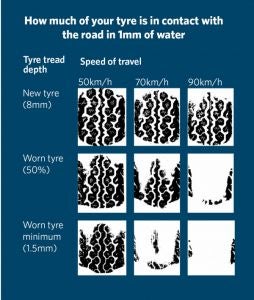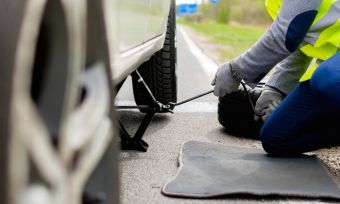Wear and tear: how long do car tyres last?
There’s no way of knowing exactly how long your car tyres will last. Their lifespan is dependent on a lot of factors, such as how often you drive, how you drive, the roads, the climate, and even the tyres themselves.
But assuming you’re driving roughly the average amount each year, on smooth paved roads, and aren’t one for traffic-light drag races, you can probably expect your car tyres to last somewhere around three to five years.
Certain factors that can adversely impact the lifespan of your car tyres include:
- Age: even a car in storage may need its tyres replaced, as tyres age over time
- Tyre pressure: incorrect tyre pressure can cause uneven wear on the tread
- Road conditions: potholes, sharp objects, kerbs, etc, can all damage your tyres
- Extreme temperatures: such as strong sunlight can increase wear and aging
- Driving habits: speeding, harsh braking, and quick takeoffs will all cause increased wear
- Weather conditions: ice, snow, and rain all require your tyres to work harder in order to maintain grip
Tyre tread: how much do I need?
The more tread the better, as this will keep you nice and safe on our roads. A new car tyre starts with around 8mm of tread, and legally, your tyres have to maintain at least 1.5mm. But you shouldn’t let it get to this point. As you can see from the image below, at 1.5mm tread, the level of grip is concerningly low.

If you’re unsure whether you have enough tread, you can use a tyre-tread checker, or take your car to a local garage and have them check for you. Another option is to use a 20c coin. If you can see the whole number 20, then your tyre tread is below 2mm, and in need of replacing.
And even if you can’t quite see the whole number, it might still be time. Your car tyres are crucial to vehicle safety. So you shouldn’t look to run them right to the ‘legal limit’ before taking action.
The correct tyre pressure
According to the New Zealand Transport Agency, “the correct tyre pressure helps improve safety, handling, fuel efficiency and extends tyre life. Correct tyre pressure can help reduce fuel consumption by up to 4%”.
The correct tyre pressure will depend on your particular vehicle. If you’re unsure what it should be, you can check the car manual/handbook, or possibly on the inside of the driver’s door. Or, next time you take your car in for a WoF and/or service, ask your mechanic.
Should You Buy a Hybrid? The Best Hybrid Cars in New Zealand
How often do car tyres need to be checked?
You should be regularly checking your car tyres for:
- Pressure
- Tread
- Any signs of damage
This should be done about once a month, as well as before any big road trips. Importantly, tyre pressure should ideally be checked cold. That means your car has been parked for at least a couple of hours, or you’ve only driven a short distance at moderate speeds. Furthermore, don’t forget to check your spare/space saver tyre at the same time.
Your car tyres should also be looked over by a professional as part of your regular servicing, or if you notice anything out of the ordinary, such as significant wear, cuts, deformations etc.
How much does it cost to replace my car tyres?
Like with anything, the price of new tyres depends on several factors. The type, size, and even brand can all play a role. But, in general, you can expect to pay around the low-mid $100 mark for a standard car tyre, though you may be able to find some cheaper options below $100.
However, before simply choosing the cheapest tyres you can find, some things to consider are:
- Different vehicles have different tyre needs – a hatchback and an SUV likely can’t use the same tyres. Typically, bigger vehicles have bigger tyres, and bigger tyres cost more
- Consider your climate – certain tyres do better in certain conditions. For example, if you live on the South Island’s West Coast, you’ll want something that can handle rain
- Consider your driving needs – do you commute to work in stop/start city traffic or do you take winding country roads? Again, different habits will require different tyres
- Your safety is at risk – cheapest is always tempting. But your tyres are the only thing that keeps you on the road. Instead of looking for the cheapest tyres, if you can afford to spend more, consider doing so.
Some other things to consider are:
- The labour costs – the above prices don’t include labour, which can run from about $30-$50 per tyre
- It’s not recommended to change a single tyre – at the very least you should change tyres in sets of two to ensure consistent and balanced handling
- Discounts and promotions are commonplace – you should be able to find regular deals, such as buy one get one half-price
- Second-hand tyres – may be an option for those on a budget. However, these will obviously come with a reduced lifespan due to previous wear
- Wheel balancing – should be included as part of your tyre change. Other services, such as wheel alignment, can typically be done at the same time, for an additional cost
Does car insurance cover car tyres?
General wear and tear, aging, burst tyres, or even damage sustained from potholes and debris are all not covered by your car insurance policy. The only instances where you may find damage to your car tyres are covered is if:
- Your car tyres have been maliciously damaged, eg. someone has slashed them
- Your car tyres have been damaged as the result of an incident that is covered by your policy. For example, in a car accident, fire, or theft.

About the author of this page
This report was written by Canstar Content Producer, Andrew Broadley. Andrew is an experienced writer with a wide range of industry experience. Starting out, he cut his teeth working as a writer for print and online magazines, and he has worked in both journalism and editorial roles. His content has covered lifestyle and culture, marketing and, more recently, finance for Canstar.
Enjoy reading this article?
You can like us on Facebook and get social, or sign up to receive more news like this straight to your inbox.
By subscribing you agree to the Canstar Privacy Policy








Share this article